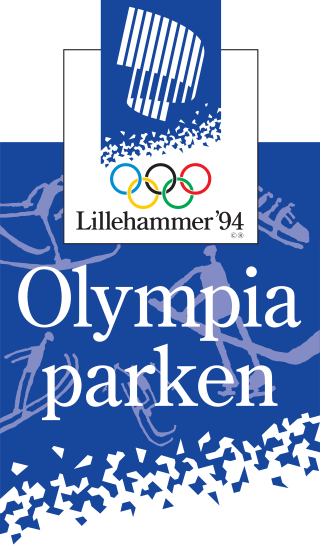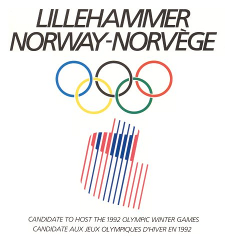
The 1994 Winter Olympics, officially known as the XVII Olympic Winter Games and commonly known as Lillehammer '94, were an international winter multi-sport event held from 12 to 27 February 1994 in and around Lillehammer, Norway. Having lost the bid for the 1992 Winter Olympics to Albertville in France, Lillehammer was awarded the 1994 Winter Games on 15 September 1988, two days before the 1988 Summer Olympics opening ceremonies at the 94th IOC Session in Seoul, South Korea. Due to the calendar changes made in 1986, this was the only time that the Winter Olympics took place two years after the previous Winter Games, and the first to be held in a different year from the Summer Olympics. This was also the first Winter Olympics to be held during the Commonwealth Games and FIFA World Cup year. This was the second Olympic Games of any type hosted in Norway — the first being the 1952 Winter Olympics in Oslo — and the fourth Olympics overall to be held in a Nordic country, after the 1912 Summer Olympics in Stockholm, Sweden, and the 1952 Summer Olympics in Helsinki, Finland. Lillehammer is the northernmost city ever to host the Olympic Games.

The 1994 Winter Paralympics, the sixth Paralympic Winter Games, were held in Lillehammer, Norway, from 10 to 19 March 1994.The Lillehammer Paralympics were the second time that the Games were held in Norway, after the 1980 Winter Paralympics in Geilo. 471 athletes from 31 countries participated, with Norway claiming the most gold medals ahead of Germany. This was the first Paralympics which the International Paralympic Committee had 100% involvement and responsibility and the first Games with their own logo.

Vikingskipet, officially known as Hamar Olympic Hall, is an indoor multi-use sport and event venue in Hamar, Norway. It was built as the speed skating rink for the 1994 Winter Olympics, and has since also hosted events and tournaments in ice speedway, motorcycle speedway, rally, association football, bandy, ice sledge speed racing, flying disc and track cycling. The arena is also used for concerts, trade fair and the annual computer party The Gathering. It is the home arena of Hamar IL bandy team. The venue is owned by Hamar Municipality, and along with Hamar Olympic Amphitheatre is run by the municipal Hamar Olympiske Anlegg. Vikingskipet has a capacity for 10,600 spectators during sporting events and 20,000 during concerts.

Lysgårdsbakken, officially known as Lysgårdsbakkene Ski Jumping Arena, is a ski jumping hill in Lillehammer, Norway. It consists of a large hill, with a K-point of 123 and a hill size of 138, and a small hill with a K-point of 90 and a hill size of 98. It opened in 1993 for the 1994 Winter Olympics, where it hosted the ski jumping and Nordic combined events, as well as the opening and closing ceremonies. After the Olympics, ownership was transferred to the municipal Lillehammer Olympiapark and it has since been used for several FIS Ski Jumping World Cup and FIS Nordic Combined World Cup tournaments, including hosting the Nordic Tournament. It has a capacity for 35,000 spectators and is one of three national ski jumping hills in Norway. In 2007, the large hill was rebuilt to a larger profile, and received a new plastic lining. The venue sees 80,000 annual jumps in the winter and 20,000 in the summer season.

Gjøvik Olympic Cavern Hall is an ice hockey rink located within a mountain hall in Gjøvik, Norway. With a capacity for 5,500 spectators, the hall also features a 25-meter swimming pool and telecommunications installations. Opened in 1993 and costing 134.6 million Norwegian krone (NOK), it was built for the 1994 Winter Olympics, where it hosted 16 ice hockey matches. It is the home of Gjøvik Hockey, has hosted the 1995 World Short Track Speed Skating Championships and is also used as an event venue. The structure is the world's largest cavern hall for public use.

CC Amfi, also known as Nordlyshallen, is an indoor sports arena in Hamar, Norway. It is mostly used for ice hockey and is the home arena of Storhamar Hockey. It has also been used for short track speed skating, figure skating, handball, events and concerts. The venue has a capacity for 7,000 spectators and was built for the 1994 Winter Olympics, where it was used for short track speed skating and figure skating. Other major events held at the arena include the 1999 IIHF World Championship in ice hockey, the 1999 World Women's Handball Championship, the 2012 IPC Ice Sledge Hockey World Championships and the 2016 Winter Youth Olympics.

Lillehammer Olympic Bobsleigh and Luge Track is a bobsleigh, luge and skeleton track located at Hunderfossen in Fåberg, Norway, 15 kilometers (9 mi) north of the town center of Lillehammer. It was completed in 1992 for the 1994 Winter Olympics, where it hosted the bobsleigh events and luge events. It has since also hosted the FIBT World Championships 1995 in skeleton and the FIL World Luge Championships 1995, and hosted 2016 Winter Youth Olympics.

The 2016 Winter Youth Olympics, officially known as the II Winter Youth Olympic Games, took place in and around Lillehammer, Norway, from 12 to 21 February 2016. They were the fourth Youth Olympic Games and the second winter edition. Lillehammer was awarded the games on 7 December 2011 as the only candidate. The games reused venues from the 1994 Winter Olympics; this made Lillehammer the first city to host both regular and Youth Olympics. In addition to Lillehammer, Olympic events were staged at venues in Hamar, Gjøvik and Øyer.

Birkebeineren Ski Stadium is a cross-country skiing and biathlon venue located in Lillehammer, Norway. Situated 3 kilometers (2 mi) from the town center and at 485 meters (1,591 ft) above mean sea level, it has two stadium areas, one for cross-country and one for biathlon. The former can accommodate 31,000 spectators, and the latter 13,500. The venue was built for the 1994 Winter Olympics, costing 83.6 million Norwegian krone (NOK). It was subsequently used by the 1994 Winter Paralympics for Paralympic Nordic skiing and Paralympic biathlon. After the games, ownership was transferred to the municipal Lillehammer Olympiapark. The venue has since been used for one Biathlon World Cup, three FIS Cross-Country World Cup and nine FIS Nordic Combined World Cup tournaments, the latter with the ski jumping competition taking place at the nearby Lysgårdsbakkene Ski Jumping Arena. Birkebeineren also hosted the 2016 Winter Youth Olympics.

Kanthaugen Freestyle Arena is a freestyle skiing stadium located in the hillside area of Kanthaugen in Lillehammer, Norway. Opened in 1992, it was built for the 1994 Winter Olympics. The venue consists of three hills—one each for aerials, moguls and ski ballet. The moguls hill has a capacity for 12,000 spectators while the other two have a 15,000-person capacity. The arena is designated as Norway's national venue for freestyle skiing. It hosted the FIS Freestyle Skiing World Cup in 1993 and 1995, and freestyle skiing and snowboarding at the 2016 Winter Youth Olympics. The arena is owned by Lillehammer Olympiapark and is located adjacent to the ski jumping hill Lysgårdsbakken.

Lillehammer Olympiapark AS, trading as Olympiaparken, is a company established following the 1994 Winter Olympics to operate the Olympic venues in Lillehammer, Norway. Owned by Lillehammer Municipality, it operates five sports venues: Birkebeineren Ski Stadium, Håkons Hall, Lillehammer Olympic Bobsleigh and Luge Track, Kanthaugen Freestyle Arena and the ski jumping hill of Lysgårdsbakken. In addition to serving sports events, the company provides tourist and group activities at the venues as well as catering to larger events.

Jens Gerhard Heiberg is a Norwegian industrialist who was head of the Lillehammer Olympic Organizing Committee (LOOC) and member of the International Olympic Committee.

The 1994 Winter Olympics were held in and around Lillehammer, Norway, from 12 to 27 February 1994. Ten competition and fourteen non-competition venues were used, most of which were subsequently used for the 1994 Winter Paralympics. The Games were spread out over ten venues in five municipalities in two counties, Oppland and Hedmark. Lillehammer, with approximately 25,000 inhabitants, and Hamar and Gjøvik, both with approximately 27,000 inhabitants, are all situated on the lake Mjøsa. Gjøvik and Hamar are 45 and 54 kilometers south of Lillehammer, respectively. Hunderfossen is 15 kilometers (9.3 mi) north of Lillehammer, but located within the municipality. Øyer and Ringebu, each with just under 5,000 inhabitants, are 18 and 50 kilometers north of Lillehammer, respectively, in the valley Gudbrandsdalen. Lillehammer had four competition venues, Hamar had two competition venues, while Hunderfossen, Gjøvik, Øyer and Ringebu had one competition venue each.

The Lillehammer bid for the 1992 Winter Olympics and Paralympics was an unsuccessful campaign launched in 1984. It bid ended fourth of seven at the 91st IOC Session on 17 September 1986, who awarded the 1992 Winter Olympics to Albertville, France. The defeat resulted in a replanned bid for the 1994 Winter Olympics, which was won by the city.
The opening ceremony of the 1994 Winter Olympics took place on 12 February 1994 at Lysgårdsbakken in Lillehammer, Norway.
The closing ceremony of the 1994 Winter Olympics was held in Lysgårdsbakken in Lillehammer, Norway on 27 February 1994. All spectators were handed a flashlight with the inscription "Remember Sarajevo" – the host of the 1984 Winter Olympics which was at the heart of the Bosnian War. The first entrants on the stage were Liv Ullmann and Thor Heyerdal, followed by the athletes' precession. After the flag had been transferred to Nagano mayor Tasuku Tsukada, speeches were held by Lillehammer mayor Audun Tron, LOOC head Gerhard Heiberg and IOC president Juan Antonio Samaranch. The latter used his speech to commemorate Sarajevo's situation, before giving Heiberg the Olympic Order in gold, and declaring the games "the best Olympic Winter Games ever". Artistic presentations followed, revisiting many of the themes from the opening ceremony. The mascots of the 1998 Winter Olympics, the "Snowlets", were also presented. Of the 2,200 people performing in the opening and closing ceremonies, only 50 were professionals.
The men's 4 × 10 km relay, a part of the cross-country skiing at the 1994 Winter Olympics, took place on 22 February at Birkebeineren Ski Stadium in Lillehammer, Norway. The race saw Italy beat Norway by 0.4 seconds on the finish line, with Finland finishing third. The three had followed each other closely through the first three rounds, but in the fourth heat, Silvio Fauner and Bjørn Dæhlie managed to break with Jari Isometsä. The event was the best attended of any in the games, with an estimated 100,000 spectators at the stadium and along the tracks. About 203,000 people applied for the 31,000 seats at the stadium, and some 75,000 ultimately watched from the track-side.
Oslo–Lillehammer 2018 was a proposal for Oslo and Lillehammer, Norway, to bid to host the 2018 Winter Olympics. Along with the Trondheim and Tromsø bids, it was one of three options for the Norwegian Olympic and Paralympic Committee and Confederation of Sports (NIF), who ultimately chose to not bid for the games. Oslo announced the bid in September 2006, and the official proposal report was published in February 2007.

The 2016 Winter Youth Olympics in and around Lillehammer, Norway, between 12 February and 21 February 2016. Nine competition and twelve non-competition venues are to be used; all except the Youth Olympic Village in Lillehammer and a training ice rink being are existing venues. All the competition venues and some of the non-competition venues were built ahead of the 1994 Winter Olympics. The games be held in four municipalities: Lillehammer, Hamar, Gjøvik and Øyer.
Henrik Andenæs is a Norwegian businessperson.














